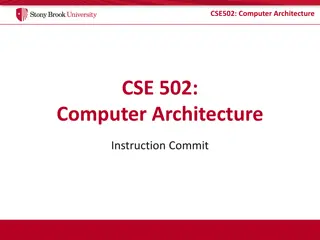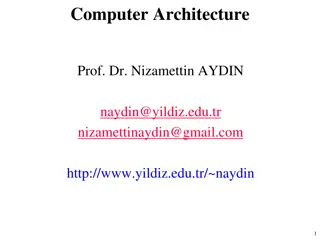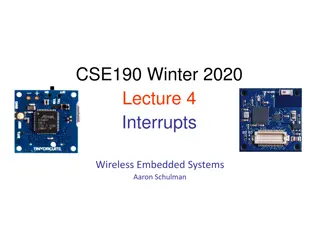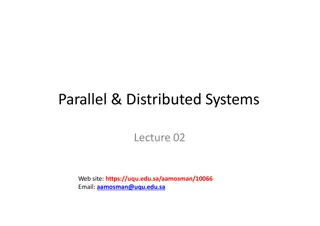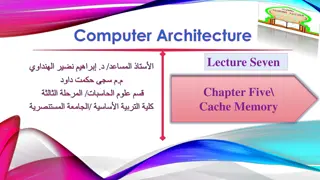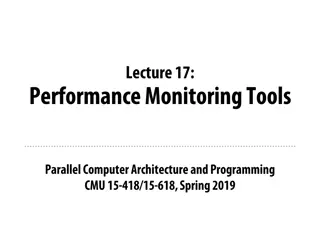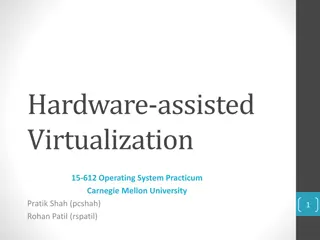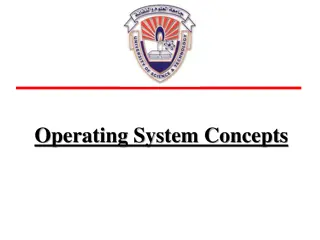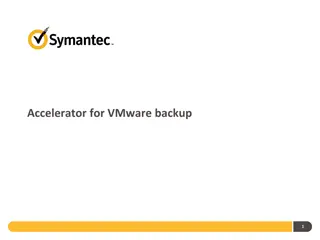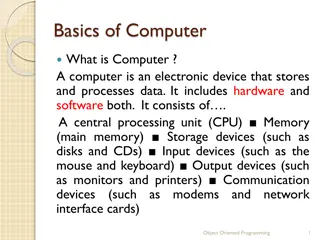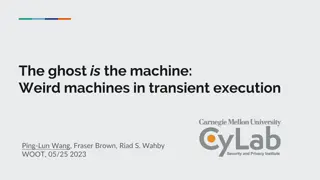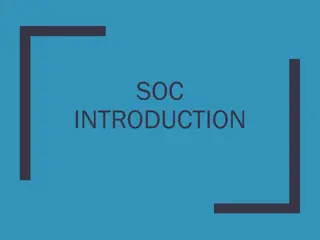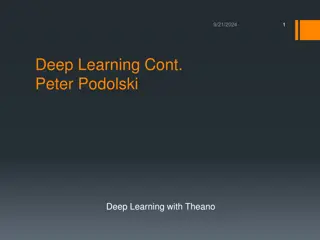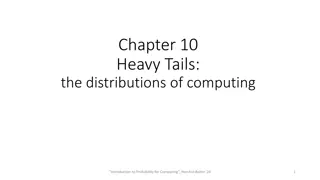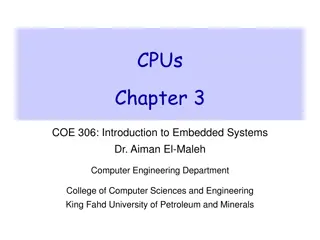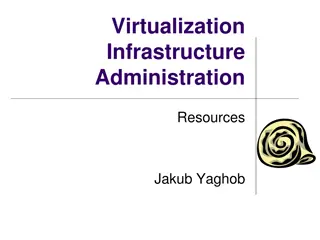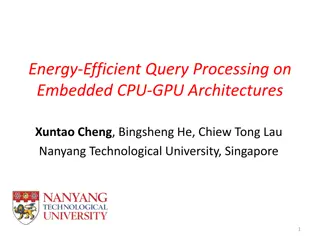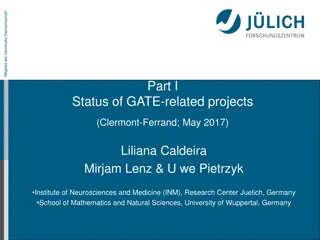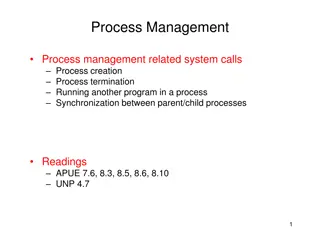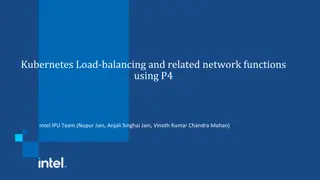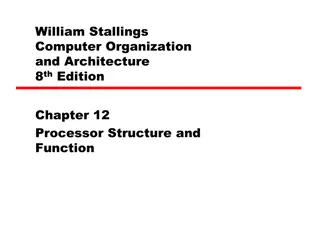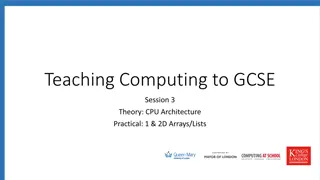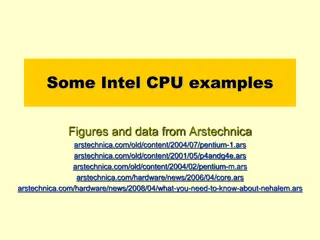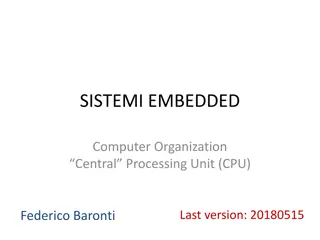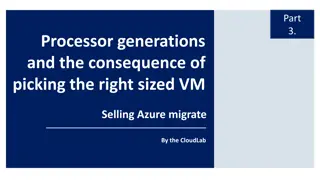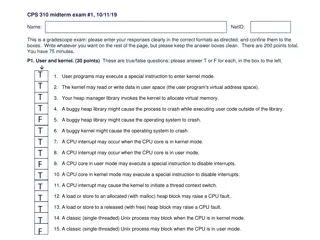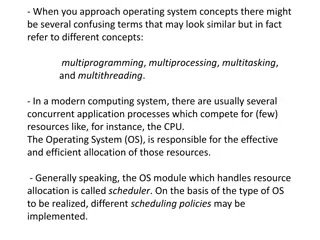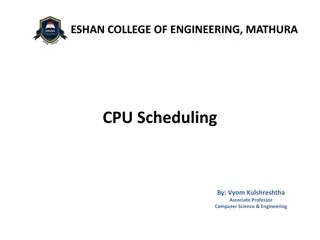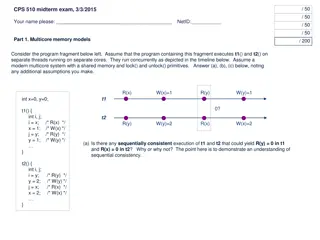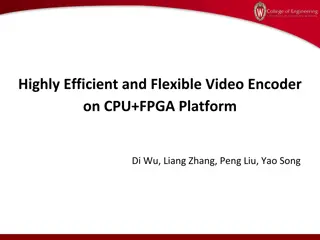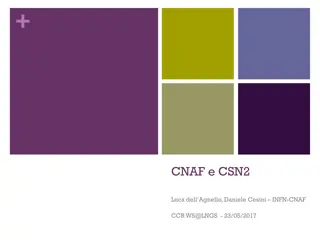Network Function Abstraction A delicate question of (CPU) affinity?
Exploring the delicate balance of CPU affinity in network function abstraction, including challenges, benefits, and solutions like CPU pinning for network workloads. Learn about the impact on performance and scalability, as well as the importance of proper configuration in virtual and physical envir
3 views • 40 slides
Understanding the Basics of Computer Hardware and CPU
Explore the fundamental concepts of information technology, focusing on hardware components like the CPU, control unit, ALU, registers, and cache memory. Learn about the functions of these parts and how they contribute to a computer's performance and speed.
3 views • 37 slides
Understanding Computer Architecture in CSE502
Exploring the intricate details of computer architecture in CSE502, covering concepts such as instruction commit, pipeline stages, program execution order, CPU state management during context switches, and implementation in the CPU. The focus is on the sequential part and the unified register file,
1 views • 26 slides
Understanding Computer Architecture: CPU Structure and Function
Delve into the intricate world of computer architecture with Prof. Dr. Nizamettin AYDIN as your guide. Explore topics such as CPU structure, registers, instruction cycles, data flow, pipelining, and handling conditional branches. Gain insights into the responsibilities of a CPU, internal structures,
0 views • 39 slides
MIPS CPU Design Using Verilog and Instruction Set Architecture Overview
Explore the world of MIPS CPU design using Verilog with a deep dive into Instruction Set Architecture (ISA), SPIM instruction formats, addressing modes, and more. Learn about the key components such as Program Counter (PC), Instruction Memory (IM), Register Files (RF), Arithmetic Logic Unit (ALU), D
1 views • 29 slides
Understanding Interrupts in Embedded Systems
In embedded systems, interrupts play a crucial role in letting peripherals notify the CPU of state changes. They are events external to the current process that disrupt the normal flow of instruction execution, typically generated by hardware devices. By using interrupts, CPUs can efficiently handle
1 views • 12 slides
Understanding von Neumann Architecture in Parallel & Distributed Systems
Exploring the von Neumann architecture, this lecture delves into the components like main memory, CPU, registers, and data transfer. It discusses the bottleneck problem and modifications made to enhance CPU performance, such as caching methods. The web presentation offers insights into key aspects o
0 views • 23 slides
Understanding Cache Memory in Computer Architecture
Cache memory is a crucial component in computer architecture that aims to accelerate memory accesses by storing frequently used data closer to the CPU. This faster access is achieved through SRAM-based cache, which offers much shorter cycle times compared to DRAM. Various cache mapping schemes are e
2 views • 20 slides
Anatomy of a Computer System: Hardware Components and Functions
A typical computer system consists of hardware and software working together to perform various computational tasks. The hardware components include the central processing unit (CPU), input/output devices, storage units, and the motherboard. The CPU acts as the main brain of the computer, performing
6 views • 6 slides
Understanding Computer Processing Systems
Computer processing systems consist of various components such as the control unit, ALU, input unit, CPU, output unit, memory, and more. Input devices feed raw data to the computer, while output devices provide processed information. The CPU plays a crucial role in executing instructions and data pr
0 views • 13 slides
System Performance Metrics Overview
Detailed system performance metrics including CPU usage, memory usage, running processes, and resource utilization presented in the form of textual data and images of system slides.
0 views • 48 slides
Hardware-Assisted Virtualization: VT-x Overview and Implementation
Explore the key concepts of hardware-assisted virtualization using Intel VT-x technology for CPU virtualization, VMX transitions, and VM control structures. Understand the motivation behind VT-x, CPU virtualization techniques, and the benefits of VT-x in simplifying VMM software. Dive into VMX opera
2 views • 28 slides
Understanding Scheduling Algorithms in Operating Systems
Exploring the world of scheduling in operating systems, this content covers various aspects such as introduction to scheduling, process behavior, bursts of CPU usage, CPU-bound and I/O-bound processes, when to schedule processes, and the differences between non-preemptive and preemptive scheduling a
0 views • 34 slides
Understanding CPU Scheduling in Operating Systems
In a single-processor system, processes take turns running on the CPU. The goal of multiprogramming is to keep the CPU busy at all times. CPU scheduling relies on the alternating CPU and I/O burst cycles of processes. The CPU scheduler selects processes from the ready queue to execute when the CPU i
0 views • 26 slides
Accelerator for VMware Backup Solutions
Today's challenges in backing up data from VMware environments include high data volume, small backup windows, slow traditional backups, network bandwidth utilization, and CPU overhead. NetBackup's Accelerator for VMware in version 7.6 addresses these challenges by using Changed Block Tracking (CBT)
0 views • 18 slides
Understanding Basics of Computer Systems
A computer is an electronic device that stores and processes data using hardware and software components. It consists of a CPU, memory, storage devices, input/output devices, and communication devices. The CPU includes a Control Unit and Arithmetic Logic Unit, and the memory stores data in bytes. St
0 views • 57 slides
Understanding Weird Machines in Transient Execution
Weird machines refer to models exhibiting unintentional behaviors triggered by adversarial inputs. They serve as computation primitives, enabling tasks like program obfuscation and secret computations. TSX weird machines, computing with time, manipulate cache states through gates like Assign, AND, O
0 views • 18 slides
Understanding Memory Management Tradeoffs in Web Browsers
Explore the tradeoffs between memory usage, CPU cost, and performance in web browsers. Learn about setting heap limits, Pareto optimality, and compositional heap limit rules to optimize memory usage efficiently.
1 views • 18 slides
Understanding System on Chip (SoC) Design and Components
Explore the world of System on Chip (SoC) design, components, and working flow. Learn about Intellectual Properties (IP), platform-based design, typical design flows, top-down design approach, and the emerging Electronic System Level (ESL) design flow. Discover the essential components of an SoC, su
0 views • 45 slides
Deep Learning with Theano: Installation, Neurons, and Exploration
Delve into the world of deep learning with Peter Podolski's comprehensive guide on utilizing Theano for neural network development. Explore topics such as installation on various systems, working with neurons, and unlocking the potential for CPU and GPU optimization. Discover insights on hidden node
0 views • 20 slides
Distributions of Computer Science in the 1990s
The study of distributions in Computer Science began in the 1990s with a focus on CPU load balancing and job migration. Concepts like preemptive migration and non-preemptive migration were explored to balance job allocations on machines. These studies laid the foundation for understanding the distri
0 views • 31 slides
Understanding Fundamental Concepts of Interrupts in Embedded Systems
Explore the fundamental concepts of interrupts in embedded systems, including interrupt handling, maskability, priority, service routines, and interrupt vectors. Learn how interrupts allow the CPU to handle special events efficiently, coordinate I/O activities, and prevent CPU tie-up, enhancing syst
0 views • 57 slides
Embedded Systems: Introduction to Input and Output Devices
This material explores the essential concepts related to input and output (I/O) devices in embedded systems. It covers examples of I/O devices, such as keyboards, mice, and disk drives, along with the digital interface between these devices and the CPU. Specific focus is given to the 8251 UART as an
0 views • 55 slides
Comprehensive Guide to Virtualization Infrastructure Administration
Explore the world of virtualization infrastructure administration, covering resources such as CPU, memory, storage, and network I/O. Learn about resource management, CPU scheduling, memory efficiency, and virtual memory management in virtualized environments. Dive into topics like vCPU mapping, prop
0 views • 10 slides
Energy-Efficient Query Processing on Embedded CPU-GPU Architectures
This study explores the energy efficiency of query processing on embedded CPU-GPU architectures, focusing on the utilization of embedded GPUs and the potential for co-processing with CPUs. The research evaluates the performance and power consumption of different processing approaches, considering th
0 views • 22 slides
Improvements and Performance Analysis of GATE Simulation on HPC Cluster
This report covers the status of GATE-related projects presented in May 2017 by Liliana Caldeira, Mirjam Lenz, and U. we Pietrzyk at the Helmholtz-Gemeinschaft. It focuses on running GATE on a high-performance computing (HPC) cluster, particularly on the JURECA supercomputer at the Juelich Supercomp
0 views • 8 slides
Understanding Process Management in Computer Systems
Exploring the concepts of process management in computer systems, including process creation, termination, running programs, synchronization between processes, and the components involved in managing processes such as memory, CPU, files, and devices. The importance of processes in sharing system res
0 views • 22 slides
Exploring Kubernetes Load Balancing with P4 Intel IPU Team
This presentation delves into Kubernetes load balancing and network functions using P4 Intel IPU technology. It covers service load balancing, control plane overview, P4 program logical view, demo initial setup, evaluation conclusions, and acknowledgements. The team aims to reduce CPU utilization, i
0 views • 8 slides
Understanding CPU Structure and Function in Computer Organization and Architecture
Exploring the intricate details of CPU architecture, this content delves into the essential tasks of fetching, interpreting, processing, and writing data. It discusses the significance of registers, user-visible registers, general-purpose registers, and condition code registers in CPU operations. Ad
0 views • 83 slides
Understanding CPU Architecture in Computing for GCSE Students
Explore the fundamental concepts of CPU architecture, including the Von Neumann Architecture, common CPU components like ALU and CU, and how characteristics such as Clock Speed and Cache Size impact performance. Learn about the Fetch-Execute Cycle and the essential hardware components of a computer
0 views • 18 slides
Intel CPU Architectures Overview: Evolution and Features
Explore the evolution and key features of various Intel CPU architectures including Pentium, Core, and Pentium 4 series. Learn about the pipeline stages, instruction issue capabilities, branch prediction mechanisms, cache designs, and memory speculation techniques employed in these processors. Gain
0 views • 11 slides
Understanding the Basics of Multi-Stage Architecture in CPU Design
The article explains the fundamentals of a multi-stage digital processing system in computer organization, focusing on the central processing unit (CPU). It covers topics such as instruction execution, processor building blocks, and the benefits of pipelined operation. Concepts like fetching, decodi
0 views • 42 slides
Understanding Processor Generations and VM Sizing for Azure Migration
Exploring the impact of processor generations on CPU performance, factors like clock speed, instruction set, and cache size are crucial. Choosing the right-sized VM plays a vital role in optimizing Azure migration. Passmark CPU Benchmark results provide insights on Intel processor generations for Az
0 views • 9 slides
Understanding User and Kernel Modes in Operating Systems
The content provided discusses various aspects of user and kernel modes in operating systems through a set of true/false questions related to user programs, CPU interrupts, heap management, and process behavior in different modes. It touches on the role of the kernel in managing virtual memory, hand
0 views • 10 slides
Understanding Operating System Concepts: Multiprogramming, Multiprocessing, Multitasking, and Multithreading
In the realm of operating systems, terms like multiprogramming, multiprocessing, multitasking, and multithreading can often be confusing due to their similar appearance but distinct meanings. These concepts play a crucial role in efficiently managing resources in a computing system, particularly in
0 views • 6 slides
Understanding CPU Scheduling Concepts at Eshan College of Engineering, Mathura
Dive into the world of CPU scheduling at Eshan College of Engineering in Mathura with Associate Professor Vyom Kulshreshtha. Explore topics such as CPU utilization, I/O burst cycles, CPU burst distribution, and more. Learn about the CPU scheduler, dispatcher module, scheduling criteria, and the impl
0 views • 18 slides
Multicore Memory Models and CPU Protection in Operating Systems
This content covers topics related to multicore memory models, synchronization, CPU protection levels in Dune-enabled Linux systems, and concurrency control in multithreaded programs. The material includes scenarios, questions, and diagrams to test understanding of these concepts in the context of t
0 views • 10 slides
Efficient Video Encoder on CPU+FPGA Platform
Explore the integration of CPU and FPGA for a highly efficient and flexible video encoder. Learn about the motivation, industry trends, discussions, Xilinx Zynq architecture, design process, H.264 baseline profile, and more to achieve high throughput, low power consumption, and easy upgrading.
0 views • 27 slides
Understanding Barrel Shifter in CPU Design
Barrel shifter is a vital component in CPU architecture, enabling shifting and rotating operations on data inputs based on control signals. The shifter consists of two main blocks - Shift-and-Rotate Array (SARA) and Control Logic. SARA, designed with multiple stages of cells, executes shift and rota
0 views • 12 slides
Overview of CNAF Research Center Infrastructure
This document provides detailed information about the infrastructure and resources at the CNAF Research Center, including CPU and storage capacities, support for experiments, resource distribution, and management of pledge requests. The content discusses the handling of CPU usage, support for variou
0 views • 31 slides


